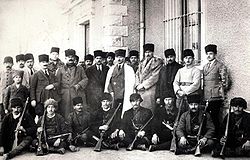- Circassians in Turkey
-
Circassians in Turkey
Türkiye Çerkezleri
Адыгэхэр Тырку/Adyghexer Tyrku
Ethem the Circassian, his Circassian hands and Mustafa Kemal Atatürk in front of the main building of the station, who were on their way to the Yozgat rebellion (June 1920) Total population 2,000,000[1][2] Regions with significant populations Adana, Amasya, Ankara, Balıkesir (Bandırma and Gönen), Bolu, Bursa (İnegöl), Bilecik, Çanakkale (Biga), Çorum, Düzce, Eskişehir, Istanbul, Izmir, Kahramanmaraş, Kayseri (Pınarbaşı), Kocaeli, Samsun, Sivas (Şarkışla and Yıldızeli), Tokat, Yozgat Languages Circassian (East Circassian and West Circassian), Abaza, Abkhaz, Turkish
Religion Related ethnic groups The Circassians in Turkey (East Circassian and West Circassian: Адыгэхэр Тырку/Adyghexer Tyrku, Turkish: Türkiye Çerkezleri) are with 2 millions (2,7% of the Turkish population) one of the largest ethnic minority in Turkey. Among the Circassians in Turkey are also the closely related ethnic groups Abazins (10,000[3]) and Abkhazians (39,000[4]) counted. The Circassians are a Caucasian immigrant people, the vast majority of them have been assimilated and only a small part still dominates one of the Circassian languages. The most Circassian predominantly speak the East Circassian (550,000 speakers) and after it West Circassian (275,000 speakers). The Circassians in Turkey are almost exclusively Sunni Muslims of Hanafi madh'hab.
Assimilation
Circassians have been almost completely assimilated due to cultural-religious closeness to Turks, dispersal of Circassians over many regions, lack of institutions promoting Circassian culture and most of all, the willingness of Circassians to assimiliate. However, this has not been completely one way as Circassians have also contributed to Turkish culture. For example, many Turkish names have Circassian origins.
Circassians in Turkey have demanded broadcasting and education rights in their native language, following the lead of Kurdish organizations and other groups.[5]
See also
References
- ^ UNPO: Tscherkessien
- ^ Ülkü Bilgin: Azınlık hakları ve Türkiye. Kitap Yayınevi, Istanbul 2007; S. 85. ISBN 9756051809 (Turkish Language)
- ^ Ethnologue: Abasinen
- ^ Ethnologue: Abchasen
- ^ Circassians in Turkey rally for their rights
Categories:- Circassian diaspora
- Ethnic groups in Turkey
- Turkey stubs
Wikimedia Foundation. 2010.

